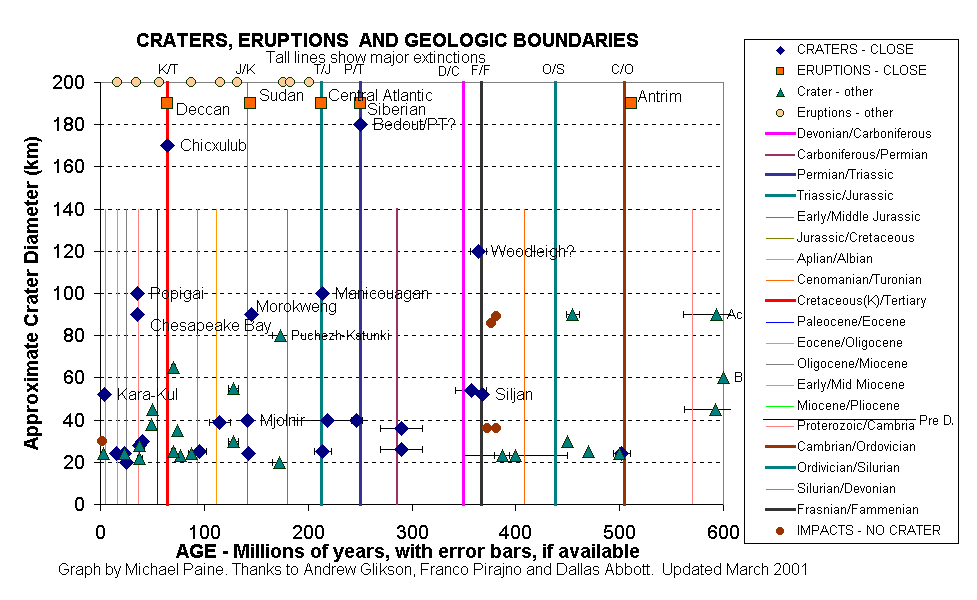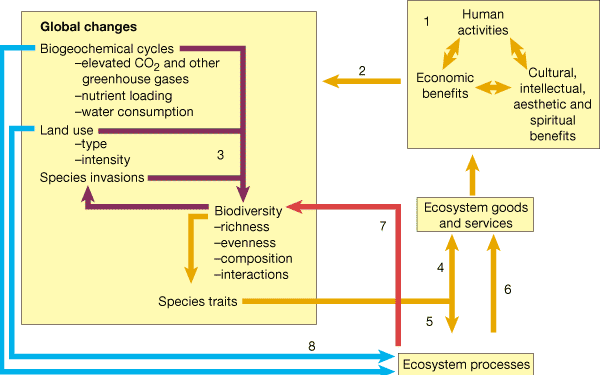Biodiversity - Invasive Species - Mass Extinctions
Ellen Thomas
Biodiversity - Invasive Species - Mass Extinctions
Ellen Thomas
We will address the following topics in a set of lectures on
biodiversity:
How do we define a Mass Extinction? Traditionally, within geological sciences, mass extinctions have been seen as some type of catastrophe for the world's biota. There have been many, long-term discussions about the importance of such catastrophes during earth history, and especially about their importance for long-term evolution. In Darwin's time (1850-1860s) the view that catastrophes were an integral part of evolution was frowned upon, and seen as a fall-back to ancient theories of catastrophism, as exemplified by the description of Noah's flood in the Bible. This view has changed recently, and modern ideas of catastrophism are part of an active discussion of 'internal' and 'external' causes of evolution. Internal causes meaning causes internal to the biota (such as competition, evolution of diseases), external meaning causes external to the biota (such as volcanic eruptions or nuclear war).
The definition of mass extinction is somewhat difficult
because the word 'catastrophe' is almost always used in relation to
human life or property loss, whereas until recently mass extinctions
were events outside human experience and influence.
The definition of 'mass extinction' must include the following:
Note that the last part of this definition strongly suggests that causes of mass extinction are dominantly external to the biota. Internal causes could possibly include the evolution of particularly virulent 'killer germ', i.e., virus or bacterium, but it is difficult to envisage one of these that would affect many different phyla, on land and in the sea. Evolution of humans might be seen as an internal cause of mass extinction, though.
Problems with this definition:
Note that we commonly do not have very good data for fossils. We must work with data on animals from which we have the best information, which is mainly animals living in shallow oceans (~1000 m deep or so). We would like to use information on species, but in many cases our information is not good enough: people disagree on what is a species, for instance. For the fossil record, data are therefore commonly shown for families. Notice that an extinction of a relatively small % of families means extinction of a much larger % of species: an extinction of about 18% of families represents extinction of about 70 % of species! (see figure below).

Extinction patterns are different between mass extinctions and
what we call 'normal' or 'background' extinction.
After mass extinction: faunas and floras dominated by 'weeds', 'pests': opportunistic species: rapid reproduction, prolific
What causes a mass extinction?
Note that our normal disasters (hurricanes, volcanic eruptions, earthquakes) resulted, during the time of human written history, in local or even regional disaster, but not in global disaster. We thus must think about processes outside human experience (non-analog case).
- Terrestrial causes
- Extraterrestrial causes
We can try to explain mass extinctions as caused by major and rapid changes in the environment. We can thus compare the effects of rapid habitat destruction as a result of natural (not human-made) widespread habitat destruction with that of anthropogenic habitat destruction, which appears to be on a similar scale of magnitude. These past habitat changes, leading to mass extinctions, must have been so major and so rapid that the biota could not react by evolution or migration, but could only become extinct. Possible causes of mass extinction external to the biota can be divided into terrestrial and extraterrestrial causes.
Terrestrial causes of mass extinction
These four different causes are not
independent from each other: global cooling, for instance, may be
caused by large-scale explosive volcanism, and this cooling may then
may result in formation of polar ice caps. If the water on Earth is
stored in polar ice caps sea level will fall, because less water is
left in the oceans. As another example,global warming may cause
oceanic anoxia (anoxia=lack of oxygen), because less oxygen can be
dissolved in water at higher temperatures.
Extraterrestrial causes of mass extinction:
The possible consequences of an impact of an asteroid or comet might include several disastrous effects for the biosphere. Obviously, the location that got a direct hit would be devastated, but what would happen over the rest of the Earth?
A high-energy impact (millions of times as energy-rich as the nuclear explosion over Hiroshima) would cause global darkness by throwing large amounts of dust as well as vaporized rock into the atmosphere. The impacting body and much of the target material (material from Earth) would be blown into the atmosphere as rocks, molten rocks, dust, and vapor. The crater would have a diameter of about 10 times the diameter of the impacting asteroid. We are not sure about impacting comets because their mass would be much less (having much water-ice) than that of a same-size asteroid, and they would almost certainly explode above the Earth's surface. At Tunguska, for example, there was no crater, and trees over thousands of square miles where blown down, radiating outward from the ground zero of explosion. The mass of the asteroid would only by about 1% of the total mass of material blown into the atmosphere. Some of the Earth's material would be blown into the atmosphere as lumps of molten rock; these lumps are called tektites if we find them: cooled and solidified, commonly black, glassy objects, which range in size from micrometers to inches.
The vaporized material would react over time with gases in the atmosphere, and form small particles in the stratosphere (higher levels of the atmosphere). The darkness would probably last a maximum of a few months; with a very heavy dust-loading of the atmosphere, particles tend to stick together, form larger particles, and fall out of the atmosphere rapidly. The darkness would limit photosynthesis, thus be effective in killing off many plants and therefore also herbivores. But plants may have had many mechanisms for survival in the long-term, even after severe damage in the short-term: seeds and roots can survive darkness and cold. Unicellular photosynthetic algae, however, have no such back-up system unless they form cysts (cells with a hard outer wall, which survive in a state of dormancy).
In addition, the darkness would cause severe cooling, for a few months. This effect would be especially severe on land and in shallow seas. If the asteroid or comet hit limestones, however, it might blow up large masses of limestones (CaCO3), the impact could blow up the limestone and then release large amounts of CO2 in the atmosphere, and thus causing global warming. This warming effect would be worse if the asteroid hit limestone covered by water, so that a large amount of water vaporized; water vapor acts as a strong greenhouse gas.
During its travel through the atmosphere, the asteroid would generate a super-acid rain. The asteroid would heat up the air that it travels through, and some of the dinitrogen gas (80% of the atmosphere) would be oxidized to NO2 by the strong heating of the air by the passage of the asteroid. The NO2 would react with water and be further oxidized to form HNO3 (which is nitric acid) according to:
4 NO2 + 2 H2O + O2 - > 4 HNO3.
This nitric acid could then rain out as very acid rain; presently, NO2 formed in car engines and power plants during high-temperature combustion is responsible for an important part of acid rain over New England. If the asteroid would have hit in an area where limestones alternate with gypsum (CaSO4), voluminous SO2-emissions could have resulted. SO2 likewise is oxidized and reacts with water in the atmosphere, according to form sulfuric acid:
2 SO2 + 2 H2O + O2 -> 2 H2SO4.
H2SO4 is sulfuric acid (battery acid). We thus have many possible mechanisms for causing major extinctions as a result of large impacts. Additional local to regional havoc could have resulted from large tsunamis if the asteroid fell in the oceans.
Over the last 550-600 million years, the time over which we have a
fossil record of multicellular animals, there have been many several
mass extinctions, five of which are commonly listed as having been
the most intense. Here they are, with suggested causes:
Five Mass Extinctions
Note that for several of these we have good evidence that more than one possible cause for mass extinction actually occurred, for instance, impact of an asteroid and of a flood basalt eruption (over a much longer time period, but including the time of extinction). The observation that an impact occurred, however, does not necessarily explain all the extinctions. During other times when large impacts occurred (see the record below, which is from this web site on Shiva theory) no mass extinctions occurred.

Our best estimates of rates of extinction during the mass extinctions of the fossil record suggest that these present rates are comparable to those during mass extinctions.
Note: Lists of threatened/extinct species of plants and animals, grouped globally by type of organism, or regionally by country, are updated each year, and available at the website of the International Union for Conservation of Nature and Natural Resources, SSC Red List Programme, IUCN/SSC UK Office, 219c Huntingdon Road, Cambridge CB3 0DL, United Kingdom
Our present time of extinction thus has been called : The sixth
extinction (not only the name of an episode
of the X-files). What are the causes
of this extinction?
This is figure 1 in Chapin, F. S., Zavaleta, E. S., Eviner, V. T.,
Naylor, R. L., Vitousek, P. M., Reynolds, H. L., Hooper, D. U.,
Lavorel, S., Sala, O. E., Hobbie, S. R., Mack, M. E., and Diaz, S.,
2000. Consequences of Changing Biodiversity. Nature vol. 405,
p. 234-242.
Figure caption quoted from paper cited: "The role of biodiversity in global change. Human activities that are motivated by economic, cultural, aesthetic and spiritual goals (1) are now causing environmental and ecological changes of global significance (2). By a variety of mechanisms, these global changes contribute to changing biodiversity, and changing biodiversity feeds back on susceptibility to species invasions (3, purple arrows). Changes in biodiversity, through changes in species traits, can have direct consequences for ecosystem services and, as a result, human economic and social activities (4). In addition, changes in biodiversity can influence ecosystem processes (5). Altered ecosystem processes can thereby influence ecosystem services that benefit humanity (6) and feedback to furthr alter biodiversity (7, red arrow). Global changes may also directly affect ecosystem processes (8, blue arrows). Depending upon the circumstances, the direct effects of global change may be either stronger or weaker than effects mediated by changes in diversity. We argue that the costs of loss of biotic diversity, although traditionally considered to be 'outside the box' of human welfare, must be recognized in our accounting of the costs and benefits of human activities."

Predictions for biodiversity in the near future:
Decrease. Question is: by how much?
Last time in Earth history that we had a combination of all continents in one place, global warming (gas hydrate blow up), oceanic low oxygen conditions: end Paleozoic (worst mass extinction of last 500 Ma; ~90 % species).

Return to first lecture on biodiversity
Return to second lecture on biodiversity